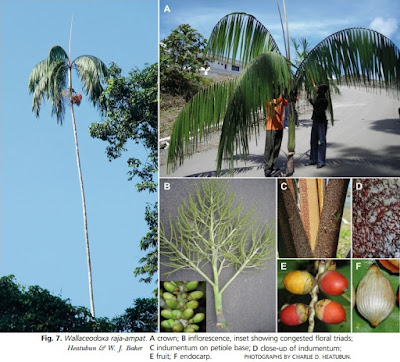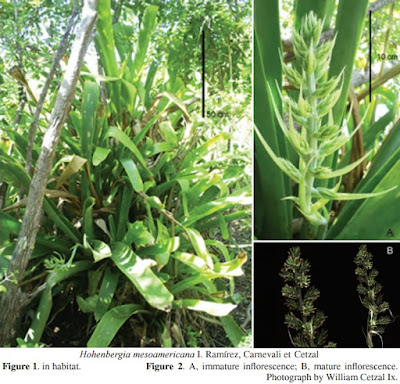[Most Recent Entries] [Calendar View]
Sunday, December 4th, 2016
| Time | Event | ||
| 3:28p | [Botany • 2014] Jailoloa halmaherensis, Manjekia maturbongsii & Wallaceodoxa raja-ampat • Three New Genera of Arecoid Palm (Arecaceae) from eastern Malesia
ABSTRACT Recent botanical exploration in eastern Malesia has resulted in the discovery of three spectacular palm taxa that have proved difficult to assign to genus. New evidence from molecular phylogenetic research indicates that these taxa should now be recognised as three monotypic genera. Here, we describe these genera as new to science, all of which are members of subtribe Ptychospermatinae (Areceae: Arecoideae). Jailoloa Heatubun & W. J. Baker is restricted to ultramafic vegetation in a single site in Halmahera and is Critically Endangered due to nickel mining. Manjekia W. J. Baker & Heatubun is scattered throughout the limestone vegetation of Biak Island, east of the Bird's Head Peninsula of New Guinea, and is Endangered, although parts of its distribution fall within a protected area. Wallaceodoxa Heatubun & W. J. Baker, named to mark the centenary of Alfred Russel Wallace's death, is found on Gag and Waigeo, two of the Raja Ampat Islands west of the Bird's Head Peninsula, where it is Critically Endangered due to its small and rapidly reducing population. Full morphological descriptions are provided with detailed comparisons with related genera, alongside a revised key to the genera of Ptychos-permatinae. These new genera are unexpected additions to the palm flora of Malesia, and demand urgent conservation attention. Keywords: Biodiversity, Eastern Indonesia, Maluku, Moluccas, New Guinea, Palmae Jailoloa halmaherensis (Heatubun) Heatubun & W. J. Baker Manjekia maturbongsii (W. J. Baker & Heatubun) W. J. Baker & Heatubun Wallaceodoxa Heatubun & W. J. Baker Wallaceodoxa raja-ampat Heatubun & W. J. Baker sp. nov. named to mark the centenary of Alfred Russel Wallace's death, is found on Gag and Waigeo, two of the Raja Ampat Islands west of the Bird's Head Peninsula, where it is Critically Endangered due to its small and rapidly reducing population. Type: Indonesia, Raja Ampat Islands Regency, Waigeo Island, Waisai, Kelurahan Warmasen, behind Kantor Bupati, forest on right side of road to Pari Convention Centre Building (tanjakan gedung Pari), 15 April 2011, Heatubun et al. 1126 (holotype MAN!; isotypes BO!, K!). ETYMOLOGY. The generic name commemorates Alfred Russel Wallace, the great English naturalist and codiscoverer of the theory of evolution by natural selection, who visited Waigeo in the Raja Ampat Islands in 1860 during his celebrated Malay Archipelago travels (Wallace 1869; van Wyhe 2013). This eponymy marks the centenary of his death on 7 November 1913. The generic name is derived by suffixing Wallace’s surname with the Greek word (-doxa) to mean “to the glory of Wallace” Charlie D. Heatubun, Scott Zona and William J. Baker. 2014. Three New Genera of Arecoid Palm (Arecaceae) from eastern Malesia. Kew Bulletin. 69(3):9525. DOI: 10.1007/S12225-014-9525-X http://www.palmtalk.org/forum/index.php? Charlie D. Heatubun. 2011. A New Species of Ptychosperma from Halmahera, North Moluccas . Palms. 55(4); 183–189. https://www.palms.org/palmsjournal/2011/v | ||
| 5:37p | [Botany • 2010] Hohenbergia mesoamericana • the First Record of the Genus (Bromeliaceae) for Mesoamerica
Abstract Hohenbergia mesoamericana I. Ramírez, Carnevali et Cetzal is proposed as new, described, and illustrated. Because the genus was previously known only from the Antilles, Colombia, Venezuela, and Brazil, this new species represents the first record of Hohenbergia for Mexico and Mesoamerica. The new species is morphologically similar to the Jamaican H. spinulosa Mez in having the bracts subtending the spikes far exceeding them (especially the lowermost) and green petals, but differs in several characters, including a more elongate peduncle and rachis resulting in a less dense infl orescence, shorter floral bracts, and pedicellate spikes. The conservation status of the new species is evaluated as critically endangered (CR) according to IUCN criteria. Key words: Bromelioideae, biogeographical disjunction, conservation, IUCN criteria, Mexico, Yucatán Peninsula. Ivón M. Ramírez-Morillo, Germán Carnevali and William Cetzal-Ix. 2010. Hohenbergia mesoamericana (Bromeliaceae), First Record of the Genus for Mesoamerica. (Hohenbergia mesoamericana (Bromeliaceae), primer registro del género para Mesoamérica). Revista Mexicana de Biodiversidad. 81: 21- 26. Resumen. Hohenbergia mesoamericana I. Ramírez, Carnevali et Cetzal se propone como especie nueva, se describe y se ilustra. El género era conocido solamente de las Antillas, Brasil, Venezuela y Colombia; por ello, este nuevo taxón representa el primer registro de Hohenbergia para Mesoamérica y México. Hohenbergia mesoamericana es morfológicamente similar a H. spinulosa Mez de Jamaica, por presentar las brácteas de las espigas muy largas (especialmente las basales) y los pétalos verdes. Sin embargo, difi ere de ella en varios caracteres, incluyendo el pedúnculo y raquis de la infl orescencia más largos, brácteas fl orales más cortas y espigas pediceladas. El estado de conservación de la especie nueva es evaluado como críticamente amenazado (CR) según los criterios del IUCN. Palabras clave: Bromelioideae, conservación, criterios IUCN, disyunción geográfi ca, México, península de Yucatán. |
| << Previous Day |
2016/12/04 [Calendar] |
Next Day >> |





